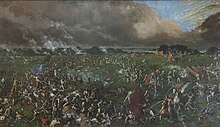Twin Sisters (Cannons).
A pair of cannons used by Texas Military Forces during the Texas Revolution and American Civil War. (last seen 1865):
The Twin Sisters are a pair of cannons used by Texas Military Forces during the Texas Revolution. They are among the most famous artillery in Texas military history with the "Come and Take It" cannon starting the revolution at the Battle of Gonzales and the Twin Sisters winning it at the Battle of San Jacinto. The Twin Sisters were also potentially used during the Mexican Invasions of 1842 and American Civil War.
Provenance:
Nearly every aspect of the Twin Sisters is debated among historians, archaeologists, and treasure hunters including their design, type (iron or bronze), caliber (four or six pounder), foundry of fabrication (Hawkins and Tatum or Eagle Iron Works/Greenwood), origin of the "Twin Sisters" moniker, where they were used, and where they disappeared.
Name:
The origin of the "Twin Sisters" moniker is debated.
The first documented use of the name comes from a letter by President of the Republic of Texas, David G. Burnet 92 days after the Battle of San Jacinto. It was written on July 22, 1836 and published in the Telegraph and Texas Register (Columbia, TX Vol. 1, No. 27, Ed. 1) on Tuesday, August 30, 1836:
An exposition of the most repeated provenance comes from Elizabeth Mars (née Rice) Stapp in a letter to the editor of The Houston Daily Post on August 24, 1897 — 61 years after the Battle of San Jacinto. It was published in the post (Vol. THIRTEENTH YEAR, No. 147, Ed. 1) on Sunday, August 29, 1897:
Texas Revolution:
The Twin Sisters played a vital role as the only Texian artillery in the Battle of San Jacinto, which effectively ended the Texas Revolution and established the Republic of Texas.
They arrived at Brazoria on March 28, 1836 and were received by Captain John M. Allen as the Texian Army, under command of General Sam Houston, was maneuvering against the Mexican Army, under command of General Santa Anna, near San Felipe de Austin, approximately 90 miles away. Fearful of interception, quartermaster general Colonel Almanzon Huston ordered the Twin Sisters to Galveston Island via the schooner Pennsylvania. They arrived on April 3 and were received by Colonel Edward Harcourt. Secretary of War David Thomas then ordered the steamboat Ohio under command of Captain Aaron Burns to retrieve them via the Buffalo Bayou for relocation to Harrisburg. The Ohio arrived at New Washington on April 6 where the schooner Flash, under the command of Captain Luke Falval and supervision of Secretary of the Navy Robert Potter, were waiting with the Twin Sisters.
The Twin Sisters arrived in Harrisburg on April 8 and were loaded onto bullock carts by Major Leander Smith, Captain John M. Allen, and Captain Alfred Henderson Wyly for transport to the Bernardo Plantation (near Hempstead) where the Texian Army was now encamped. The 44,000 acre plantation was the first and largest cotton plantation in Texas. It was established by Old Three Hundred settler Jared E. Groce who freely provided refuge to the Texian cause. Stalled by the "sea of mud" from April showers, the detachment completed the 60 mile trip on April 13. They are received by Lieutenant Colonel James C. Neill, who assigns a company of nine soldiers to each cannon:
Antebellum:
Mexican Invasions of 1842:
The last documented mention of the Twin Sisters occurred during the ongoing military raids and expeditions that followed the Texas Revolution, including a report ordering them to defense in 1842, and a work order in 1843, indicating they may have been used:
- 23 June 1842, ordered to San Felipe de Austin by Secretary of War & Marine George W. Hockley "to be in readiness for transportation to any point that may be designated in opening the mediated campaign."
- Note: Hockley was the commanding officer of artillery during the Battle of San Jacinto
- 24 March 1843, ordered by the Ordnance Department to Frederick Schierman for various maintenance.
Houston Twins:
- 13 December 1841, used for Sam Houston's inauguration as President of the Republic of Texas.
- 1853, used for BBB&C Railway's dedication ceremony.
- 1859, used for Sam Houston's inauguration as Governor of Texas.
Legacy:
- 7 April 1895, Andrew Jackson Houston gifted Santa Anna's dagger, a war trophy from the Battle of San Jacinto, to Cincinnatians.
- 2 March 1897, University of Texas students "borrowed" a Twin from the capitol and fired it for Texas Independence Day, establishing a Texas Exes tradition.
- 1910, Featured on Sam Houston Grave Monument designed by Pompeo Coppini.
- 1939, Twin Sisters Monument featured at San Jacinto Monument.
- 1985, Twin Sisters exhibit featured in the San Jacinto Museum. Fabricated by students at University of Houston College of Technology.
- 1992, Twin Sisters exhibit featured in the Great Hall of Texas Military Forces Museum. Fabricated in 1975 by the "Guard of the Republic" to celebrate the bicentennial of the United States.






💖💖
ReplyDelete